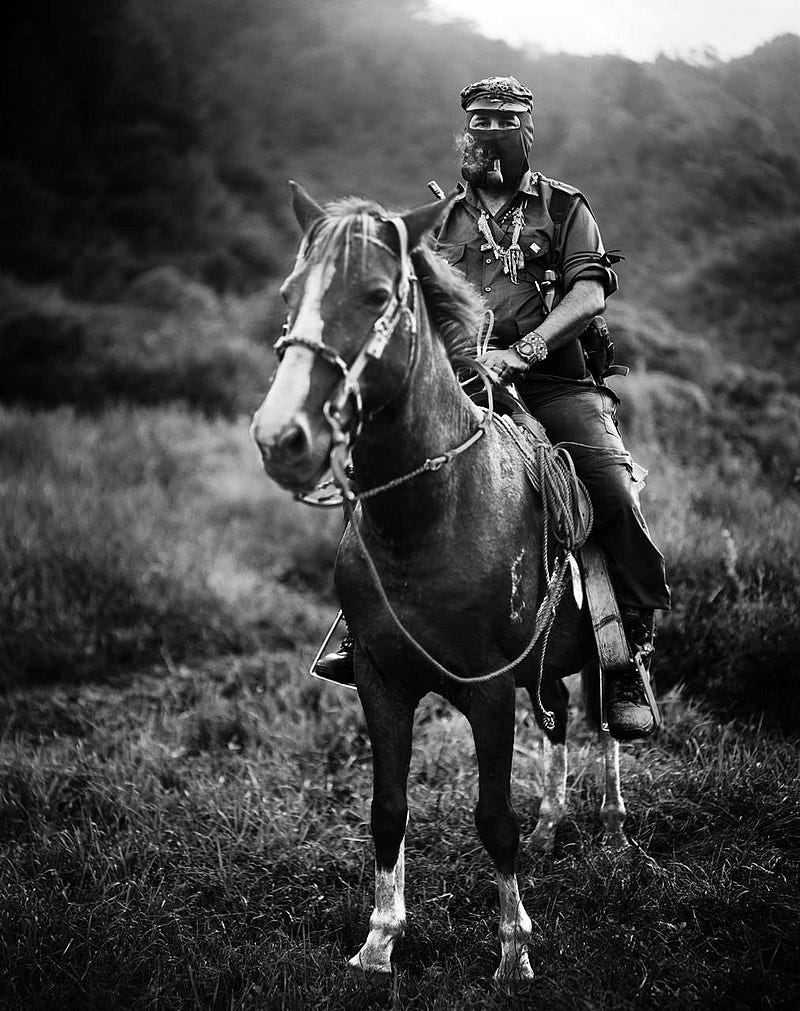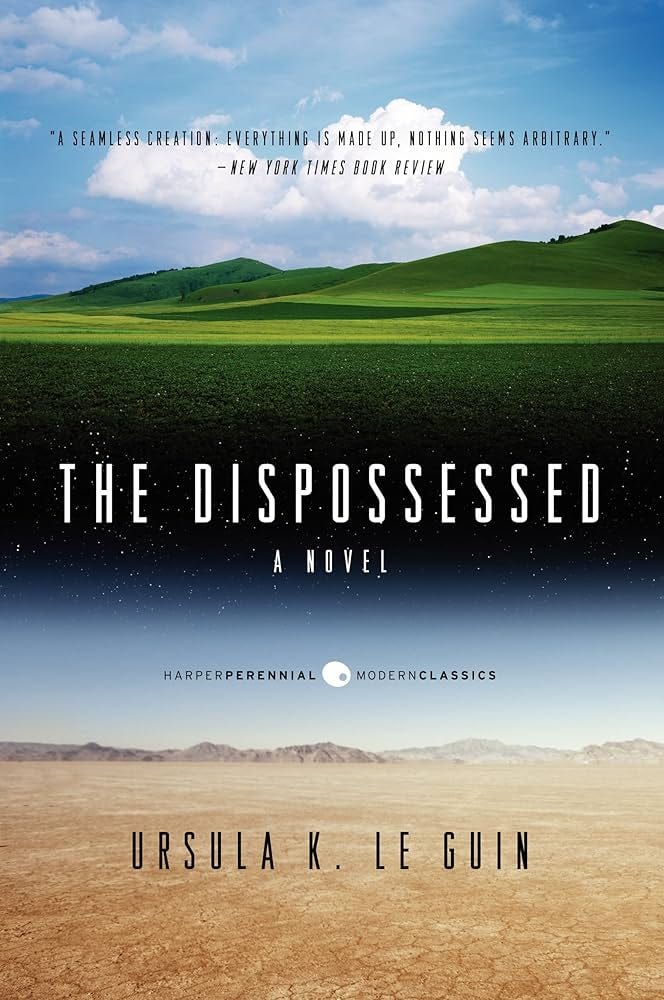Anarchism, Explored
An eclectic mix of past, present and future reflections on anarchism
Close your eyes and picture anarchy.
Do you see the desolate landscape of the Mad Max saga, headlined by Immortan Joe with his emblematic skeletal mask and Coma Doof, the flame-throwing guitar-rocker? Or maybe you imagine the villains of The Purge, murdering and pillaging through their brutal, lawless society? For many, anarchism is synonymous with pop-culture depictions of chaotic dystopias, characterized by perpetual violence.
Yet for others, anarchism conjures vastly different images. Anarchism is a political ideology adopted by revolutionary activists, anti-colonial movements, science-fiction writers and abolitionist organizers. While it would be preposterous to define a concept inherently opposed to restricting structure, some common themes across various conceptions of anarchism are:
Voluntary, non-coercive, collectivized labor relationships: People work for the benefit of each other, not because they are forced to, or would otherwise starve.
No central state: No prisons, no police, no borders, no militaries. Governance structures are local, decentralized and non-hierarchical.
Individuality: Each person’s individual spirit and autonomy guide their life, rather than the predetermined norms of a rigid society.
Abundance: Without coercive labor and commodified production, self-organized communities provide for themselves with abundance. There are ample resources for every person to have food, shelter, health care, and capacity to pursue whatever endeavors they choose.
This piece explores past, present and future conceptions of anarchism.
Anarchism in theory
Emma Goldman
Emma Goldman was a revolutionary organizer, leader, and theoretician during the inception of the anarchist movement in the United States. Goldman moved from Lithuania to New York City in 1885, where during her first day in the city, she stumbled into Sachs' Café, stomping grounds for radical New Yorkers. She was soon engrossed by anarchist ideology and became a prominent spokesperson. During a period of economic depression in 1893, Goldman spoke to a crowd of 3,000 workers in Union Square about anti-capitalist violence, urging workers to “take everything… by force.” She was arrested for inciting a riot, and a police sergeant offered her clemency in return for informing on her fellow New York radicals. She responded by throwing a glass of water in his face.
Some of Goldman’s most impacted political work occurred in 1916, when she traveled the country advocating for birth control by organizing public demonstrations about how to properly use contraception. She was also a vocal anti-war activist during the height of the Red Scare of WWI, which eventually led the U.S. federal government to deport her to Russia.
Anarchism was the guiding principle of Goldman’s political organizing. She wrote multiple essays about anarchism, including: “Anarchism and Other Essays.” She offers some succinct definitions of anarchism, including:
“The philosophy of a new social order based on liberty unrestricted by man-made law; the theory that all forms of government rest on violence, and are therefore wrong and harmful, as well as unnecessary.”
“The philosophy of the sovereignty of the individual. It is the theory of social harmony. It is the great, surging, living truth that is reconstructing the world, and that will usher in the Dawn.”
“An order that will guarantee to every human being free access to the earth and full enjoyment of the necessities of life, according to individual desires, tastes, and inclinations.”
The emphasis of individuality is noteworthy because of how individualism is a core idea of capitalist ideology. Goldman discusses aspects of “individual endeavor” such as growth, aspiration and self-realization, which she believes should shape people’s lives. The capitalist flavor of “individualism” is distinct from anarchist “individual autonomy,” because it is rooted in beliefs that people should care primarily for themselves, and that individual success or failure in rigged production/consumption markets reflects one's self-worth.
Collectivism is another aspect of Goldman’s anarchism. She imagines labor based on local, voluntary production and non-competitive, de-commodified networks of distribution, balancing mutually-reinforcing principles of individuality and collective well-being.
Sounds great in theory, but is anarchism really attainable in practice?
Zapatista Movement
On January 1st 1994, the Zapatista Army of National Liberation (EZLN) declared war on the Mexican state. Indigenous peasants, who for decades had peacefully protested the government’s support for neoliberal policies which siphoned indigenous land rights to private landowners, had reached a breaking point. In Chiapas, the southernmost province of Mexico, the Zapatista movement took root, led by Indigenous peasants who were radicalized when the state responded to their non-violent tactics with violent repression during the “Mexican Dirty War.”
On New Years’ Day, 1994, the Zapitistas attacked city halls, released political prisoners, and seized farm land privately owned by absent landlords. After years of battling and negotiating with the Mexican government, the EZLN won sovereignty over the majority of Chiapas.
The governance structure implemented by the EZLN, which some have likened to anarchism, is rooted in local self-organization, a harmony between individual autonomy and communal reciprocity. Local assemblies at the village level are the lifeblood of EZLN governance and are where the majority of decision making happens. There are also regional municipalities, made up of assembly delegates who serve short terms and are wholly accountable to the villages they hail from. Municipalities elect delegates to the third and highest tier of governance, called the Juntas de Buen Gobierno (JBG), or Councils of Good Government (as opposed to the “bad” Mexican government). The JBG connects regional municipalities to happenings around Chiapas. All ideas proposed at the JBG undergo an intensive local consultation process, after which delegates share their communities’ opinion in regional municipal meetings. Decisions are made by consensus, which sometimes involves intense day-long meetings where all opinions are voices and no decision is made until a compromise is reached.
The Zapatistas refuse aid from the Mexican government and self-operate all services typically run by the state, including education and healthcare. There is also no state police system in the EZLN-sovereign Chiapas. Zapatistas still have public safety infrastructure, however the “officers” are unarmed and uninformed civilians who are elected by their local assemblies. The function of public-safety workers is to mediate issues among members of the community, and between Zapatistas and non-Zapatista visitors.
The Zapatista slogan “Para todos todo” or “Everything for everyone,” describes the emphasis of abundance and mutual-aid rather than scarcity and competitive resource distribution.
Ok sure, the Zapatistas made it work for a period of time in a single region of Mexico, but is anarchism really feasible on a national or global level?
Everything for Everyone
Unfortunately, we have no modern example of an anarchist society developing on a level broader than Chiapas. However, the minds of brilliant fiction writers allow us to imagine what this might look like, and how it might emerge.
M.E. O’Brien’s and Eman Abdelhadi’s speculative fiction book Everything for Everyone, An Oral History of the New York Commune, 2052-2072, offers a great resource to imagine a better world.
The book chronicles a successful near-future global anti-capitalist insurrection that coalesces amidst climate catastrophe and nuclear war, and a future of human existence that rises from the ashes of collapse. Global revolution begins in Palestine, spreads across the Levant region, and eventually to New York where the story takes place. Each chapter is a different fictional interview with people who made the revolution, discussing one aspect of how New York has transformed. This transformation is quintessentially anarchist.
The main theory of the book is that people’s needs (food, housing, clothes) can be met in abundance without coercive labor relationships. Economies are organized in small, local assemblies with decisions made on the neighborhood level. Labor is collectivized and there are no nation-states nor commodified production. Like the EZLN, local assemblies communicate with each other on regional, even global levels to make decisions and exchange resources when necessary. But people primarily organize themselves by neighborhood units. The world that Abdelhadi and O’Brein build is not utopian; there are tensions and traumas from prior decades, but there is infrastructure in place to wrestle with conflict.
Eman Abdelhadi says in an interview with Al-Mahdi Institute:
“What if in the midst of social collapse, the good guys win and we emerge with a better society.”
I highly recommend picking up a copy (or I’ll lend you mine if you’re in the Twin Cities)!
Cool story, but what about anarchism on an intergalactic level?
The Dispossessed
Science-fiction and fantasy writer Ursula K. Le Guin wrote The Dispossessed against the backdrop of the Vietnam War. Tired of reading endless justifications for war, Le Guin decided to write a story about a different society. The Dispossessed is set in the aftermath of the Odonian Revolution, named after the anarchist revolutionary Odo who becomes disillusioned with capitalism on her home planet Uras and writes a series of popular manifestos. Odo’s anarchist movement grows with such force among the people of Uras, that the Urassati government extends an offer: ‘migrate to the vacant planet Anarres and we will let you build your anarchist utopia in peace.’
Over decades, the supporters of Odo build a functioning anarchist society on Anarres, which is where the narrative of The Dispossessed begins.
Le Guin’s depiction of Anarres does not rely on a turning-back of technology; in fact, Anarres is a place of great innovation, with scientists unhindered by commodified gatekeeping of technological innovation. There are no written laws on Anarres, no prisons, no private property, no coercive labor. Instead, a syndicate structure allows people to voluntarily sign up for labor positions across the planet. A central computing system developed by the Anarresi determines what the economic needs of the planet are, and creates labor positions accordingly. People’s affinity for communalism compels them to sign-up for work positions. There is a tension between this authority and individual autonomy throughout the narrative, showing the complexity of a society without a state. Some shun the syndicate system and are drifters in society, but still have access to social safety structures that are guaranteed to every human, regardless of productivity.
The world that Le Guin constructs is an imperfect, nuanced example of anarchism functioning on an intergalactic level. In a later short story, “The Day Before the Revolution,” Le Guin writes:
“Anarchism’s principal target is the authoritarian State (capitalist or socialist); its principal moral-practical theme is cooperation (solidarity, mutual-aid). It is the most idealistic, and to me the most interesting, of all political theories).”
I asked a few friends to share some words about what anarchism means to them!
Griffy LaPlante
“When I was a Daisy Scout, I balked at being told to memorize the Girl Scout Pledge. What was this strange oath, and why was I, a five-year-old, yearling to this world, expected to recite it? I already had to profess loyalty to a country I hadn’t chosen to be born in, and now this? I quit the Scouts and took up refusing to recite the Pledge of Allegiance, sometimes brazenly, other times by just not moving my mouth when the principal came on the loudspeaker and the whole school was instructed to stand and partake in it. I didn't learn the word "fascism" until years later, but I felt it in my little body.
That was my earliest education in anarchism, which to me is a taste and a predilection, a tendency away from conformity and doing what authority figures tell us to do. Naturally, there are times when it is helpful and right to do as we are told, but not always, not even most of the time. This is what anarchism values and promises to defend: the right to question, to critique, to think slowly and skeptically before allowing oneself to be governed. Anything that denies such rights, be it a public school or a Communist mutual aid group, is flirting with tyranny. When we sense that tyrannical itch, I think the task before us is to be as attentive as possible to our instincts for self-determination. Which often means being persistent and annoying, even when accusations of difficulty or white/femme/queer/[insert identity label here] fragility are made against us.”
Check out more of Griffy’s writing
Genna
“I first took anarchism seriously after my dear friend Mira offered me the chance to read her copy of Anarchism and Its Aspirations by Cindy Milstein. I read it sitting by the fire on a camping trip in the fall of 2020. I closed the book, thought for a second, and said to myself, “I am not sure. I think I still believe in hierarchy.”
It took reading another one of Cindy’s books, this time an anthology they edited called Deciding for Ourselves, to find myself moved and grounded by anarchist thought. In the introduction they write of times where they find themselves in temporary but profound movement of self governance, where time stretches out, where you realize how you already have everything you need - what they call “as if we were already free” moments. And I have been lucky enough to experience that in my life and my organizing.
I realized that I had been influenced by anarchists from the beginning of my time organizing against the Line 3 pipeline; words like spokescouncil and affinity group woven into the conversations before I recognized them as the anarchist catchphrases they are. And as I’ve learned more, read more, and lived more, I’ve tentatively but comfortably settled into anarchism with fewer hesitations.
I feel less and less certain that we can do anything meaningful to shift the power imbalances of the world. I don’t think we should stop trying, but I feel more optimistic about collapse than much else. I believe in the ways we can build small and big practices, connections, and systems to take care of each other in the ever unfolding, multidimensional collapse. Sometimes I wonder if an embrace of anarchism is a way to avoid the hard responsibility of confronting power. Is it a way to sit around with my friends, cooking 60 cups of rice at a time, making art and Shabbat dinners and stockpiling water and not having to dirty my hands with the real questions of politics? Can we seize power? Should we? (For what it’s worth, you should read If We Burn by Vincent Bevins and then also read Deciding for Ourselves, mentioned above, and then call me so we can tussle about this).
For me, it’s about an embrace of possibility and humanity. That it would be ludicrous to believe there’s one way to usher in a new world, or that we can coerce people into it. I believe in the coexistence of autonomy and hierarchy and know that there’s nothing more punk rock than having a structure in place. I have no interest in orthodoxy, doctrinism, or colluding with the state to sell out comrades. I am interested in orienting to the world through an anarchist lens, flexibly - remembering to invest in the means rather than the ends, that saving one life is saving a universe, that what people need is food, water, aid, and each other.”
You can subscribe for free to be notified when I share new writing.
If you’re able to financially support my work, paid subscriptions allow me to spend more hours writing! Free subscriptions and sharing with friends is also helpful and I am appreciative of each and every one of you






Joseph!!!!!!! I wrote a long essay on Goldman in grad school. Thank you as always.
I’ve been waitin for this one🔥